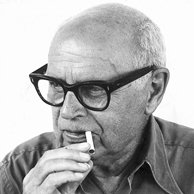Poul Henningsen
architect, writer, designer (1894-1967)
Poul Henningsen was born in Ordrup, Denmark in 1894, architect and designer who is considered a pioneer of lighting technology.
After studying at the Copenhagen School of Technology, he worked as an independent architect from 1920, designing houses, industrial buildings, part of the Tivoli and the interiors of two theatres.
Known for his lamps, Poul Henningsen has engaged in various fields, in addition to architecture and design, he has distinguished himself as a poet, writer, journalist, art critic, composer and editor.
In his writings, a very fine critical personality emerges, both towards architecture and society in general.
Poul Henningsen is considered a pioneer in the study of electric light, his models are the result of years of scientific studies on the subject. The aim is to eliminate reflections and generate a soft and comfortable light.
The screens of Henningsen's lamps are made up of separate elements, modeled and assembled in such a way as to cover the bulb and direct the light beam onto the table below or in the surrounding area, without reflections of an expected order and a diffused light.
Living in Copenhagen, Poul Henningsen travels across the city by tram. During these trips he looks into the houses and observes how depressing they are. In this regard he says: “The furniture, the carpets, the style of a home are nothing compared to the importance of the positioning of the light. Enlightenment doesn't cost much, but it requires culture."
In 1924 Poul Henningsen designed his first multi-screen lamp, based on the scientific analysis of the function of the screens which determine the distribution, diffusion of light and the quantity of reflections. This first lamp was awarded at the World Exhibition in Paris and is known as the Paris-Lamp. The principles on which the design of this lamp is based are maintained throughout subsequent production.
The lamps of the PH series and the Artichoke in particular represent icons of contemporary design. Poul Henningsen lamps are produced by Louis Poulsen.
The collaboration with Louis Poulsen began in 1924, when the designer proposed producing the first model of the PH system (the name derives from Poul Henningsen's initials).
The collaboration between designer and company led to participation in the Paris International Exhibition of 1925, where they won the gold medal and subsequently the creation of some great successes in the lighting sector including the PH5, Louvre, Snowball and 'iconic Artichoke.
The materials and shapes adopted for the lamps are traditional, with a functional design designed for the masses, they are ideal for residential spaces but also inside shops, operating rooms, even reaching the pavilions of the 1925 Auto Show and to the lighting of tennis courts and greenhouses. Poul Henningsen's pieces are used in some of the most important creations in the world, from the Louvre to the Danish Museum of Decorative Arts, to the famous Tivoli Park in Copenhagen, where they are still present.
Danish architect Poul Henningsen, known by his initials, "PH", was obsessed with light. He is the legendary creator of the series of lights named after him. It can be said that he is the first lighting architect in the world. Poul Henningsen has dedicated his entire career to investigating the importance of light for our well-being. He worked on the theory that the observer should not be subjected to direct glare from the electric light source. Henningsen used a series of layered shades to diffuse the light and hide the bulb, thus creating softer, more diffused lighting.
Henningsen, together with Alvar Aalto, contributed to the spread of functionalism in Scandinavia. At the Stockholm Exhibition of 1930 there were examples of functionalism, but the innovative principles of the Bauhaus only became established after the war.
From the 1940s Denmark began to export its products, thanks also to the rules for advertising and distribution. Only products selected by special commissions that judge their quality are admitted to national exhibitions.
In this period, the Scandinavian social democratic governments supported programs to educate and raise awareness among the population about the principles of modern living, in collaboration with consumer cooperatives.
Henningsen himself published the first magazine in defense of the consumer, trying to stimulate his younger colleagues to take critical positions.











